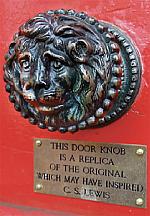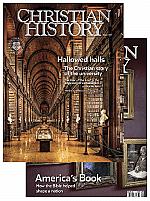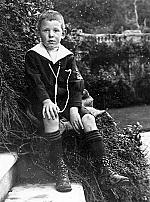Hallowed halls: Recommended resources CH 139
Books
Introduce yourself to the topic with George Marsden, The Outrageous Idea of Christian Scholarship (1997); Arthur Holmes, Building the Christian Academy (2001); C. John Sommerville, The Decline of the Secular University (2006); Mark Noll and James Turner, edited by Thomas Albert Howard, The Future of Christian Learning: An Evangelical and Catholic Dialogue (2008); James Axtell, Wisdom’s Workshop (2016); George Williams, Wilderness and Paradise in Christian Thought (2nd ed., 2016); M. J. Toswell, Today’s Medieval University (2017); Jens Zimmerman, ed., Re-Envisioning Christian Humanism (2017); and Margarita Mooney, Love of Learning (2021).
For more on medieval universities, consult Hilde De Ridder-Symoens, Universities in the Middle Ages (1992); R. W. Southern, Scholastic Humanism and the Unification of Europe (1995, 2001); David B. Priest, Jürgen Miethke, and William J. Courtenay, eds., Universities and Schooling in Medieval Society (2000); and Joseph Koterski and Ronald Begley, eds., Medieval Education (2005).
Among the few English books on the University of Paris are Ian Wei’s Intellectual Culture in Medieval Paris (2012) and William Courtenay’s Rituals for the Dead (2018). For Oxford and Cambridge, look at The University of Cambridge: A New History (2004) and The University of Oxford: A New History (2010) by G. R. Evans. Not much is available on Prague and Leipzig in English except for A History of Charles University (2001) by František Kavka, translated from Czech.
For higher education in Europe from the Reformation onward (including Wittenberg), consult Hilde De Ridder-Symoens, Universities in Early Modern Europe (1996); Helga Robinson-Hammerstein, European Universities in the Age of Reformation and Counter Reformation (1998); Paul Grendler, The Universities of the Italian Renaissance (2002); Thomas Albert Howard, Protestant Theology and the Making of the Modern German University (2006); and Zachary Purvis, Theology and the University in Nineteenth-Century Germany (2016). Read more on Halle in Douglas Shantz, An Introduction to German Pietism (2013) and his edited volume, A Companion to German Pietism, 1660–1800 (2015), as well as in Thomas Ahnert, Religion and the Origins of the German Enlightenment (2006) and Richard Gawthrop, Pietism and the Making of Eighteenth-Century Prussia (2006).
For more on the story of higher education in America, look at Julie Reuben, The Making of the Modern University (1996); Jon Roberts and James Turner, The Sacred and the Secular University (2000); Andrea Turpin, A New Moral Vision (2016); and George Marsden, The Soul of the American University Revisited (2021) and, edited with Bradley J. Longfield, The Secularization of the Academy (1992). To understand religion and the Ivy League in particular, some useful books are Conrad Cherry’s Hurrying Toward Zion (1995) and Paul Kemeny’s Princeton in the Nation’s Service (1998).
Read more about John Henry Newman’s views on education in A. Dwight Cuyller, The Imperial Intellect (1955). You can also read The Idea of a University in a modern critical edition (1976) edited by Ian Ker.
For more on Oberlin, consult John Barnard, From Evangelicalism to Progressivism at Oberlin College, 1866–1917 (1969); Roland M. Baumann, Constructing Black Education at Oberlin College (2010); and J. Brent Morris, Oberlin, Hotbed of Abolitionism (2014). To learn more about Wheaton, consult W. W. Willard, Fire on the Prairie (1950) and David Maas, Marching to the Drumbeat of Abolitionism (2010).
Finally, for more on college campus revivals, look at J. Edwin Orr, Campus Aflame (1971); Timothy K. Beougher and Lyle W. Dorsett, eds., Accounts of a Campus Revival (1995); Michael Gleason, When God Walked on Campus (2002); and Robert Coleman, One Divine Moment (2nd ed., 2013).
Christian History issues
Read past issues on our website—some are still available for purchase:
10: Pietism
34, 39, and 115: Martin Luther
68: Jan Hus
108: Charlemagne
113: Seven Literary Sages
116: 25 Writings that Changed the Church and the World
Videos from Vision Video
Videos on this issue’s topic include God’s Glory, Neighbor’s Good; History of Christianity (especially parts 2 and 3); How Should We Then Live?; In the Footsteps of Martin Luther; John Hus; Opening the Door to Luther; People of Faith; Truth Prevails; and Where Luther Walked. These are also available to stream at RedeemTV.com.
Websites
Many universities discussed in this issue still operate today, and you can visit their websites and browse. Most have fairly extensive sections detailing their institutional histories. If you want to dig deeper into some of the historical figures and terms discussed, the Stanford Encyclopedia of Philosophy is one place to start. Read pre-twentieth-century figures in their own words at the Christian Classics Ethereal Library and Post-Reformation Digital Library (the PRDL also has a marvelous set of links to other sites with primary sources), as well as the Internet Medieval Sourcebook and the Internet Modern History Sourcebook.
The Cardinal Newman Society has quite a bit on modern education as well as Newman’s educational ideals. The Council on Christian Colleges and Universities is a network of explicitly Christian schools, and the Consortium of Christian Study Centers is a network of study centers exploring questions of faith at schools both religious and secular. CH
By the editors and contributors
[Christian History originally published this article in Christian History Issue #139 in 2021]
Next articles
Jack at home: did you know?
Encounters with C. S. Lewis around the hearth and along the byways
the editorsSupport us
Christian History Institute (CHI) is a non-profit Pennsylvania corporation founded in 1982. Your donations support the continuation of this ministry
Donate







